《新编大学英语》翻译教学课件(PPT讲稿,第三版第二册,Translation and Writing)Lecture6正译与反译(2)反说正译1
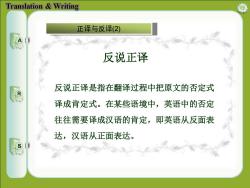
Translation Writing 正译与反译(2) 反说正译 反说正译是指在翻译过程中把原文的否定式 译成肯定式。在某些语境中,英语中的否定 往往需要译成汉语的肯定,即英语从反面表 达,汉语从正面表达
反说正译 反说正译是指在翻译过程中把原文的否定式 译成肯定式。在某些语境中,英语中的否定 往往需要译成汉语的肯定,即英语从反面表 达,汉语从正面表达。 正译与反译(2)
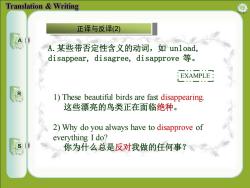
Translation Writing 正译与反译(2) A.某些带否定性含义的动词,如unload, disappear,disagree,disapprove等。 :EXAMPLE 1)These beautiful birds are fast disappearing 这些漂亮的鸟类正在面临绝种。 2)Why do you always have to disapprove of everything I do? 你为什么总是反对我做的任何事?
A.某些带否定性含义的动词,如 unload, disappear, disagree, disapprove 等。 1) These beautiful birds are fast disappearing. 这些漂亮的鸟类正在面临绝种。 2) Why do you always have to disapprove of everything I do? 你为什么总是反对我做的任何事? EXAMPLE 正译与反译(2)
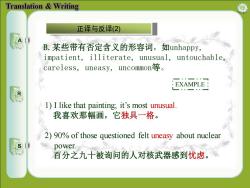
Translation Writing 正译与反译(2) B.某些带有否定含义的形容词,如unhappy, impatient,illiterate,unusual, untouchable, careless,uneasy, uncommon等。 :EXAMPLE 1)I like that painting;it's most unusual 我喜欢那幅画,它独具一格。 2)90%of those questioned felt uneasy about nuclear power. 百分之九十被询问的人对核武器感到忧虑
B.某些带有否定含义的形容词,如unhappy, impatient, illiterate, unusual, untouchable, careless, uneasy, uncommon等。 正译与反译(2) EXAMPLE 1) I like that painting; it’s most unusual. 我喜欢那幅画,它独具一格。 2) 90% of those questioned felt uneasy about nuclear power. 百分之九十被询问的人对核武器感到忧虑
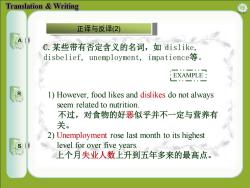
Translation Writing 正译与反译(2) C.某些带有否定含义的名词,如dislike, disbelief,unemployment,impatience EXAMPLE 1)However,food likes and dislikes do not always seem related to nutrition. 不过,对食物的好恶似乎并不一定与营养有 关。 2)Unemployment rose last month to its highest level for over five years. 上个月失业人数上升到五年多来的最高点
EXAMPLE C.某些带有否定含义的名词,如 dislike, disbelief, unemployment, impatience等。 1) However, food likes and dislikes do not always seem related to nutrition. 不过,对食物的好恶似乎并不一定与营养有 关。 2) Unemployment rose last month to its highest level for over five years. 上个月失业人数上升到五年多来的最高点。 正译与反译(2)

Translation Writing 正译与反译(2) D.某些词组和句型,如no more t than (仅仅),in no time (立刻),not more than(最多),i none but(只有),none other than(正是), cannot help·(情不自禁),not until (直到) 等 EXAMPLE 1)I will have no doubt that he will succeed 我坚信他会成功。 2)You cannot be too careful in crossing the street 过马路时你们千万要加倍小心
EXAMPLE D.某些词组和句型,如no more than (仅仅),in no time (立刻),not more than (最多),none but (只有),none other than (正是),cannot help… (情不自禁),not until (直到) 等。 1) I will have no doubt that he will succeed. 我坚信他会成功。 2) You cannot be too careful in crossing the street. 过马路时你们千万要加倍小心。 正译与反译(2)
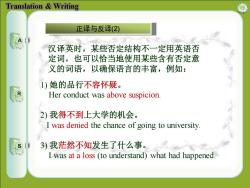
Translation Writing 正译与反译(2) 汉译英时,某些否定结构不一定用英语否 定词,也可以恰当地使用某些含有否定意 义的词语,以确保语言的丰富,例如: 1)她的品行不容怀疑。 Her conduct was above suspicion 2)我得不到上大学的机会。 I was denied the chance of going to university. 3)我茫然不知发生了什么事。 I was at a loss (to understand)what had happened
汉译英时,某些否定结构不一定用英语否 定词,也可以恰当地使用某些含有否定意 义的词语,以确保语言的丰富,例如: 正译与反译(2) 1) 她的品行不容怀疑。 Her conduct was above suspicion. 2) 我得不到上大学的机会。 I was denied the chance of going to university. 3) 我茫然不知发生了什么事。 I was at a loss (to understand) what had happened

Translation Writing Translation Practice 1.Rapid and inexpensive transport and communication may threaten national cuisines. 快速及便宜的交通运输业会威胁到民族烹饪。 2.Students in this class with no exception must answer all the questions. 这个班的同学统统必须回答所有的问题。 3.镇中心变化很多,根本认不出来了。 The town center has changed beyond all recognition. 4.我们迟到了,未能听到音乐会的第一部分。 We were late and missed the first part of the concert
Translation Practice 2. Students in this class with no exception must answer all the questions. 这个班的同学统统必须回答所有的问题。 1. Rapid and inexpensive transport and communication may threaten national cuisines. 快速及便宜的交通运输业会威胁到民族烹饪。 3. 镇中心变化很多,根本认不出来了。 The town center has changed beyond all recognition. 4. 我们迟到了,未能听到音乐会的第一部分。 We were late and missed the first part of the concert
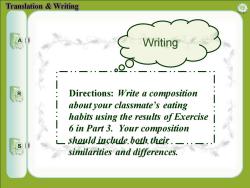
Translation Writing Writing R Directions:Write a composition about your classmate's eating habits using the results of Exercise 6 in Part 3.Your composition L should include.both their._.._ similarities and differences
Writing Directions: Write a composition about your classmate’s eating habits using the results of Exercise 6 in Part 3. Your composition should include both their similarities and differences
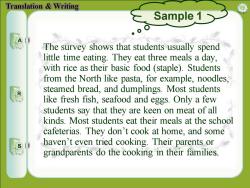
Translation Writing Sample 1 The survey shows that students usually spend little time eating.They eat three meals a day, with rice as their basic food (staple).Students from the North like pasta,for example,noodles, steamed bread,and dumplings.Most students like fresh fish,seafood and eggs.Only a few students say that they are keen on meat of all kinds.Most students eat their meals at the school cafeterias.They don't cook at home,and some haven't even tried cooking.Their parents or grandparents do the cooking in their families
Sample 1 The survey shows that students usually spend little time eating. They eat three meals a day, with rice as their basic food (staple). Students from the North like pasta, for example, noodles, steamed bread, and dumplings. Most students like fresh fish, seafood and eggs. Only a few students say that they are keen on meat of all kinds. Most students eat their meals at the school cafeterias. They don’t cook at home, and some haven’t even tried cooking. Their parents or grandparents do the cooking in their families
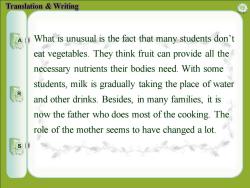
Translation Writing AWhat is unusual is the fact that many students don't eat vegetables.They think fruit can provide all the necessary nutrients their bodies need.With some students,milk is gradually taking the place of water and other drinks.Besides,in many families,it is now the father who does most of the cooking.The role of the mother seems to have changed a lot
What is unusual is the fact that many students don’t eat vegetables. They think fruit can provide all the necessary nutrients their bodies need. With some students, milk is gradually taking the place of water and other drinks. Besides, in many families, it is now the father who does most of the cooking. The role of the mother seems to have changed a lot
按次数下载不扣除下载券;
注册用户24小时内重复下载只扣除一次;
顺序:VIP每日次数-->可用次数-->下载券;
- 《新编大学英语》翻译教学课件(PPT讲稿,第三版第二册,Translation and Writing)Lecture5正译与反译(1)正说反译2.ppt
- 《新编大学英语》翻译教学课件(PPT讲稿,第三版第二册,Translation and Writing)Lecture10误译分析2.ppt
- 《新编大学英语》翻译教学课件(PPT讲稿,第三版第二册,Translation and Writing)Lecture10误译分析1.ppt
- 《新编大学英语》翻译教学课件(PPT讲稿,第三版第二册,Translation and Writing)Lecture5正译与反译(1)正说反译1.ppt
- 《新编大学英语》翻译教学课件(PPT讲稿,第三版第二册,Translation and Writing)Lecture4抽象与具体2.ppt
- 《新编大学英语》翻译教学课件(PPT讲稿,第三版第二册,Translation and Writing)Lecture4抽象与具体1.ppt
- 《新编大学英语》翻译教学课件(PPT讲稿,第三版第二册,Translation and Writing)Lecture3英译汉省略译法(3)其他词类的省略2.ppt
- 《新编大学英语》翻译教学课件(PPT讲稿,第三版第二册,Translation and Writing)Lecture3英译汉省略译法(3)其他词类的省略1.ppt
- 《新编大学英语》翻译教学课件(PPT讲稿,第三版第二册,Translation and Writing)Lecture2英译汉省略译法(2)省略介词和连词2.ppt
- 《新编大学英语》翻译教学课件(PPT讲稿,第三版第二册,Translation and Writing)Lecture2英译汉省略译法(2)省略介词和连词1.ppt
- 《新编大学英语》翻译教学课件(PPT讲稿,第三版第二册,Translation and Writing)Lecture1英译汉省略译法(1)省略代词和冠词2.ppt
- 《新编大学英语》翻译教学课件(PPT讲稿,第三版第二册,Translation and Writing)Lecture1英译汉省略译法(1)省略代词和冠词1.ppt
- 《新编大学英语》翻译教学课件(PPT讲稿,第三版第一册,Translation and Writing)09 直译与意译2.ppt
- 《新编大学英语》翻译教学课件(PPT讲稿,第三版第一册,Translation and Writing)09 直译与意译1.ppt
- 《新编大学英语》翻译教学课件(PPT讲稿,第三版第一册,Translation and Writing)08 词义增补(2)其他词类增补2.ppt
- 《新编大学英语》翻译教学课件(PPT讲稿,第三版第一册,Translation and Writing)05 词类转译(1)名次和动词转换2-1.ppt
- 《新编大学英语》翻译教学课件(PPT讲稿,第三版第一册,Translation and Writing)05 词类转译(1)名次和动词转换1-1.ppt
- 《新编大学英语》翻译教学课件(PPT讲稿,第三版第一册,Translation and Writing)04 词义的引申2-1.ppt
- 《新编大学英语》翻译教学课件(PPT讲稿,第三版第一册,Translation and Writing)04 词义的引申1-1.ppt
- 《新编大学英语》翻译教学课件(PPT讲稿,第三版第一册,Translation and Writing)03 词义的选择2-1.ppt
- 《新编大学英语》翻译教学课件(PPT讲稿,第三版第二册,Translation and Writing)Lecture6正译与反译(2)反说正译2.ppt
- 《新编大学英语》翻译教学课件(PPT讲稿,第三版第二册,Translation and Writing)Lecture7英语习语的翻译1.ppt
- 《新编大学英语》翻译教学课件(PPT讲稿,第三版第二册,Translation and Writing)Lecture7英语习语的翻译2.ppt
- 《新编大学英语》翻译教学课件(PPT讲稿,第三版第二册,Translation and Writing)Lecture8英汉语言句法差异概述1.ppt
- 《新编大学英语》翻译教学课件(PPT讲稿,第三版第二册,Translation and Writing)Lecture8英汉语言句法差异概述2.ppt
- 《新编大学英语》翻译教学课件(PPT讲稿,第三版第二册,Translation and Writing)Lecture9语序处理1.ppt
- 《新编大学英语》翻译教学课件(PPT讲稿,第三版第二册,Translation and Writing)Lecture9语序处理2.ppt
- 《新编大学英语》翻译教学课件(PPT讲稿,第三版第三册,Translation and Writing)Lecture 01 被动语态的翻译1/2.ppt
- 《新编大学英语》翻译教学课件(PPT讲稿,第三版第三册,Translation and Writing)Lecture 01 被动语态的翻译2/2.ppt
- 《新编大学英语》翻译教学课件(PPT讲稿,第三版第三册,Translation and Writing)Lecture 02 否定句的翻译1/2.ppt
- 《新编大学英语》翻译教学课件(PPT讲稿,第三版第三册,Translation and Writing)Lecture 02 否定句的翻译2/2.ppt
- 《新编大学英语》翻译教学课件(PPT讲稿,第三版第三册,Translation and Writing)Lecture 03 某些比较结构的翻译1/2.ppt
- 《新编大学英语》翻译教学课件(PPT讲稿,第三版第三册,Translation and Writing)Lecture 03 某些比较结构的翻译2/2.ppt
- 《新编大学英语》翻译教学课件(PPT讲稿,第三版第三册,Translation and Writing)Lecture 04 定语从句的翻译(1)限制性定于从句的翻译1/2.ppt
- 《新编大学英语》翻译教学课件(PPT讲稿,第三版第三册,Translation and Writing)Lecture 04 定语从句的翻译(1)限制性定于从句的翻译2/2.ppt
- 《新编大学英语》翻译教学课件(PPT讲稿,第三版第三册,Translation and Writing)Lecture 05 定语从句的翻译(2)非限制性定于从句的翻译1/2.ppt
- 《新编大学英语》翻译教学课件(PPT讲稿,第三版第三册,Translation and Writing)Lecture 05 定语从句的翻译(2)非限制性定于从句的翻译2/2.ppt
- 《新编大学英语》翻译教学课件(PPT讲稿,第三版第三册,Translation and Writing)Lecture 06 名词性从句的翻译(1)1/2.ppt
- 《新编大学英语》翻译教学课件(PPT讲稿,第三版第三册,Translation and Writing)Lecture 06 名词性从句的翻译(1)2/2.ppt
- 《新编大学英语》翻译教学课件(PPT讲稿,第三版第三册,Translation and Writing)Lecture 10 误译剖析1/2.ppt
